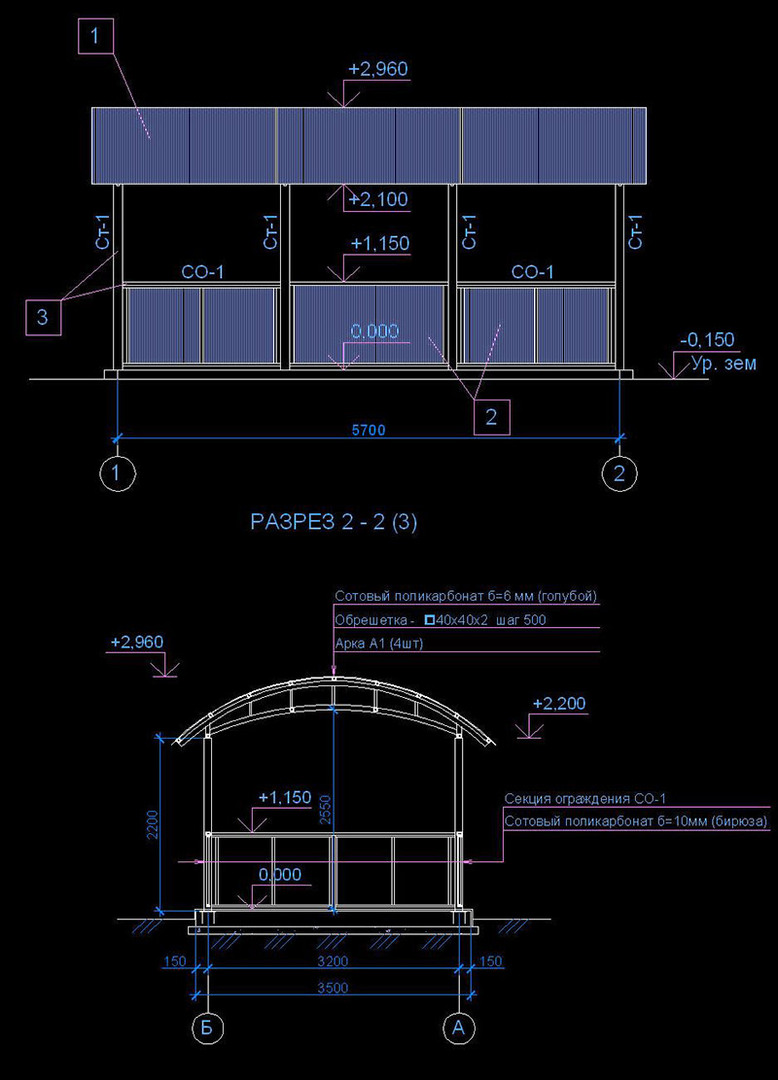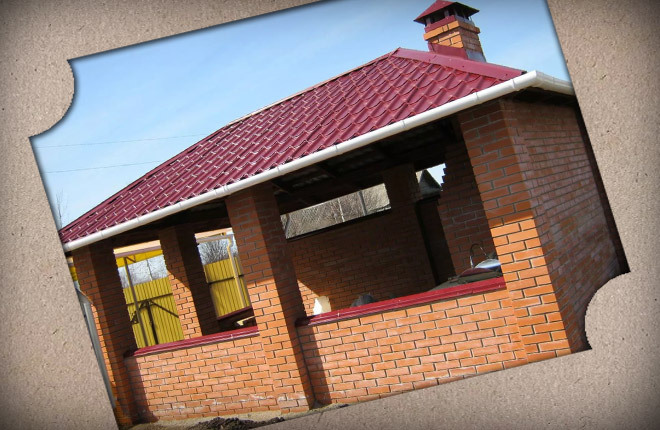The process of building a hexagonal gazebo with your own hands from the outside looks quite complicated. But this is just a first impression due to the complex design of the roof frame. Only laying the roof will require more accuracy. However, a gazebo with a hexagonal roof noticeably outperforms a conventional one with a gable or hipped roof. Nice design, interior space is used more efficiently than rectangular or square buildings.
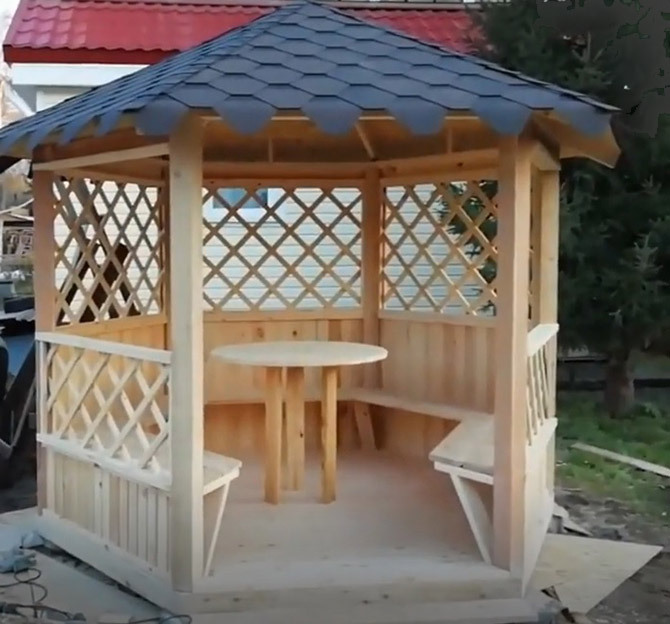
The content of the article:
-
Preparatory stage
- Choice of materials and tools
- Blueprints
-
Construction - step by step instructions
- markup
- Foundation
- Connections in the bottom harness
- Pole installation
- Floor
- Top harness
- Roof erection
- Roof selection and installation
- Results
Preparatory stage
There are three main ways to build a hexagonal gazebo:
- Assemble from a professional pipe and a corner, but in this case it will be necessary to make a slab or pile foundation.
- Make a forged building out of steel bar and rebar. You can add decorative plastic elements with imitation of forging.
- Build a wooden gazebo with a hexagonal roof.
Of the above, the forged version of the construction is the most difficult to manufacture and the most time-consuming. Working with forging requires experience and skills, therefore, if this is the first experience in building a gazebo, it is better to refuse the forged version.
The easiest way is to build a hexagonal gazebo with your own hands from a profile pipe and a steel corner. It will take a couple of days to build. But you need to be able to properly weld the frame. In addition, the appearance of the building is not very attractive, the design of the welded structure from the corrugated pipe turns out to be too “industrial”.
For a home gazebo with a hexagonal roof, wood is best. Everyone knows how to work with a board and a bar with their own hands, the building will turn out to be “warm”, beautiful, even without varnishing wooden parts.
Choice of materials and tools
For the manufacture of a wooden frame will be used:
- timber 150x150 mm;
- timber 50x50 mm;
- edged board 40x200 mm;
- rail 40x20 mm;
- concrete blocks;
- cement, sand, gravel.
The roof will require four OSB sheets and shingles. Accordingly, under it you will need to buy fasteners (nails), glue and lining material. In addition, you will need to choose the right paint and varnish so that the coating is smooth and does not fade in the solar ultraviolet.
From tools:
- shovel;
- wheelbarrow;
- capacity for mixing concrete;
- electric jigsaw, hand circular saw;
- electric drill, screwdriver;
- carpentry measuring tool - tape measure, square with a grid of angles in degrees.
In addition, you will need fasteners - carpentry screws from 40 to 120 mm, wide-head nails, wood glue. Separately, it will be necessary to find several pieces of roofing material for waterproofing the foundation.
You will have to order in advance or make yourself a center for assembling the hexagonal roof frame. Without it, it will not be possible to assemble the roof. The center is a hexagonal prism cut from a 90x90 mm bar. The tops of the triangles forming the slopes of the gazebo will rest on it.
Blueprints
Each builder, before starting work, draws up a working sketch of the future building. It is clear that it is necessary to have a general drawing in order to calculate the estimate, order materials and stock up on tools.
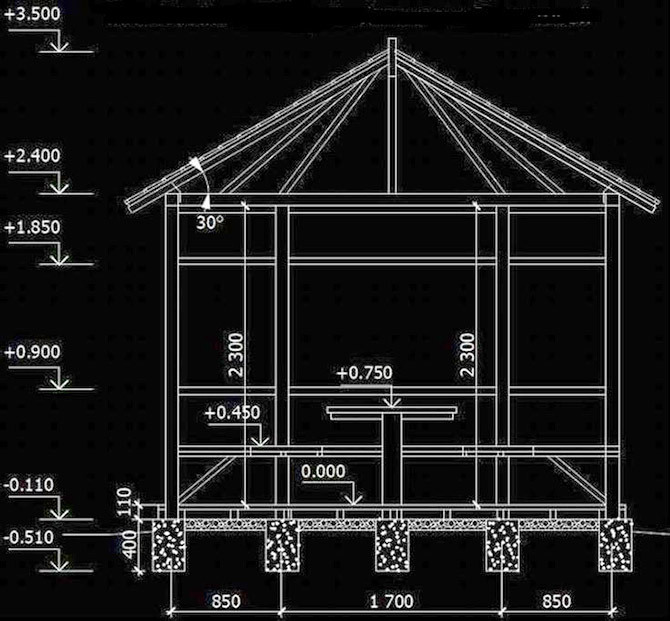
But, in addition to detailed drawings, you will need a sketch, assembly diagram or step-by-step instructions. It will help to avoid such an unpleasant phenomenon as the use of blanks for other purposes.
The assembly diagram of a hexagonal gazebo can be drawn by hand or a specialized program can be used.
The gazebo will be installed on pillars, the frame of the hexagonal building is quite light, so it is not advisable to fill the slab or make a hexagonal shallow foundation.
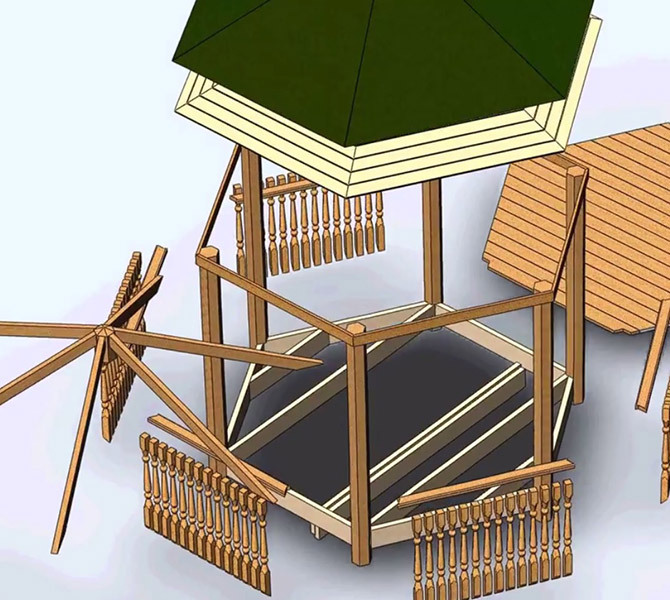
The hexagonal frame is formed by vertical posts made of timber and two strappings - lower and upper. The lower one is used for laying logs and subsequent laying of a plank floor. The rafters of the hexagonal roof will rest on the top trim. Both harnesses will need to be carefully adjusted, otherwise the vertical posts will look uneven, respectively, the whole ceremonial appearance of the hexagonal arbor will be spoiled.
Construction - step by step instructions
Construction begins with the preparation of the site in the country. The minimum area is 3x3 m. Even if the gazebo is planned to be built directly at the house, the first step is to carefully remove all grass, weeds, and with roots.
Experts recommend digging and compacting the site, after arranging the columnar foundation, fill it with fine gravel.
markup
The hexagonal gazebo has an equilateral hexagon at its base. This means that the radius of a circle in which a hexagonal figure can be inscribed will be equal in length to one of the sides of the hexagon. In fact, marking the foundation for a hexagonal building is considered one of the simplest, it is almost impossible to make a mistake.
First you need to draw a circle. This can be done with a peg hammered into the ground and a cord. The length of the rope is chosen equal to one of the sides of the hexagonal arbor. The method is simple, but its accuracy is low due to the fact that the rope tends to stretch.
For marking hexagonal foundations with edge lengths up to 1.8 m, a manual surveyor can be used. It consists of three solid wooden planks knocked together in the shape of the letter "A". The distance between the lower ends of the inclined bars (the base of the "letter") is chosen equal to the radius of the circle. It turned out to be a kind of huge compass. With it, you can mark the foundation for a hexagonal gazebo with an accuracy of a millimeter.
It remains only to select the center on the site, draw a circle and, using a land surveyor, mark on the circumference the installation points for future pillars for the foundation of the gazebo.
Foundation
The hexagonal arbor will be mounted on poles partially submerged in the ground. You will need to install seven supports: six around the circumference, one in the center of the gazebo.
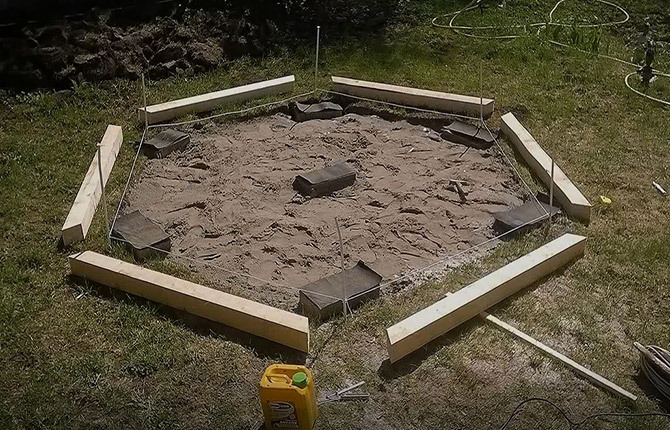
If the soil is heavy, rocky, then asbestos-cement pipe trimmings, 40-50 cm long, can be used as pillars. A hole in the ground is cut out with a garden drill or, if there is a lot of rubble, knocked out using a 125 mm steel water pipe with a serrated edge. After pouring concrete into the pipes, a foundation will be obtained that can withstand a hexagonal gazebo with "passengers" with a total weight of up to a ton.
On soft soil (chernozem, greasy clay), holes will need to be dug with a shovel to a depth of 25 cm. Sand and gravel are poured to the bottom and molds are set for pouring. The formwork can be knocked down from scraps of an inch board or you can use a plastic ready-made blank for growing flowers in flower beds.
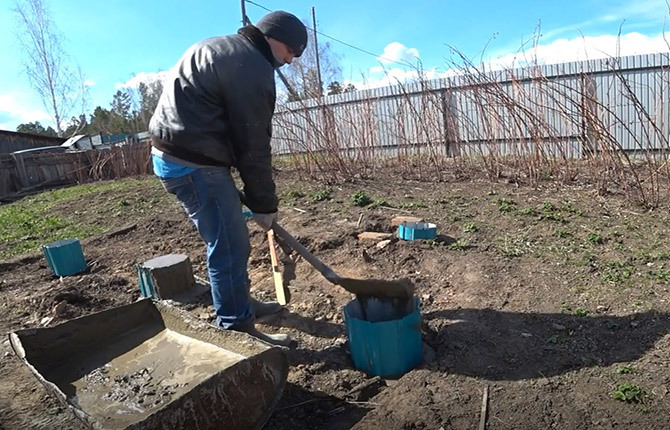
Advice! Before pouring concrete into the mold, it is necessary to align them so that all the supporting platforms of future columns are located in the same plane.
Immediately, until the pouring has set, it is necessary to lay one M16 steel stud into the concrete so that over the concrete the surface protruded by about 4/5 of the thickness of the beam, from which the lower hexagonal trim will be made gazebos.
It will take at least 7 days for the concrete pour to harden. If the construction of the hexagonal gazebo took place during the hottest time of the year, then the forms must be covered with a film. After the concrete has set, the film is removed, pieces of a two-layer glass roofing material are glued (on mastic) to the pillars.
Connections in the bottom harness
The next step is to lay the trimmings from the timber around the perimeter on the pillars. This is the bottom harness. Each blank is cut out with a length equal to the side of the frame of the hexagonal gazebo, plus another 5 cm.
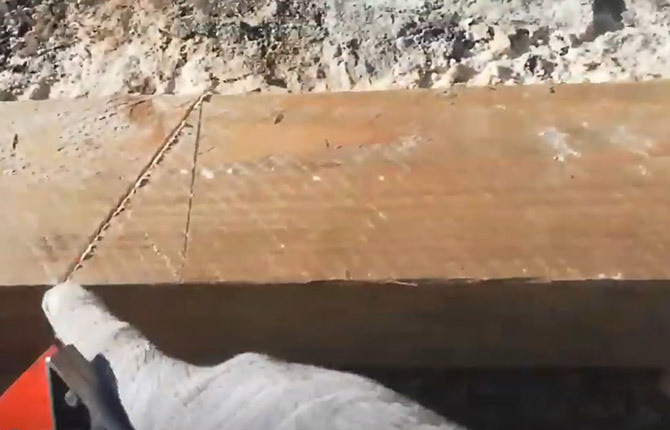
Before laying, the ends of the segments must be cut down at an angle of 60O to the side surface. After cutting, the blanks are laid on poles. It is clear that the joint between two adjacent sections of the hexagonal strapping should be located in the center of the column support area.
To begin with, we will drill a hole in the beam and fix the end with a stud concreted in a column, as well as washers and nuts. We will pull the end of the adjacent timber with the help of three 120 mm self-tapping screws. The nut must be 80% tightened. The final tightening is performed after the installation of the vertical racks of the hexagonal frame.
The stiffness of the hexagonal strapping turned out to be large enough, but still insufficient for the installation of vertical poles. Therefore, before mounting the vertical supports (they will be the corners of the hexagonal frame), it is necessary to cut logs into the lower trim for the plank floor of the gazebo.
For log beams, boards 150x30 mm can be used. Initially, you need to install one pair of logs in the center, between the opposite edges of the strapping. Logs can be cut into a timber beam or fixed with steel corners and self-tapping screws.
In the middle between the lag beams, a lining board is laid. Its thickness is chosen so that both logs rest through the lining on the foundation column. All parts are sewn with self-tapping screws.
In addition, it will be necessary to lay one more lag beam to the left and right of the H-shaped structure. Fasten with screws to the beam. The basis for the floor of the hexagonal gazebo is ready, you can move on to the racks and the roof.
Pole installation
For vertical supports, a beam of 100x100 mm is used. The material is pre-cleaned with a hand grinder. After installing the support into the frame of the hexagonal arbor, it will be much more difficult to grind.

The blank of the vertical column is installed at the junction between the strapping beams (above the foundation pillar) in approximately a vertical position and fixed with strut strips stuffed on the sides. This is the most critical stage in the construction of a hexagonal gazebo, since each pillar must be aligned vertically as accurately as possible.
At least one assistant is needed for the final alignment of the post, but you can try to set up the post alone. You will have to sequentially unfasten one or the other brace, while moving the beam, checking the position of the column with the building level until the device shows in perpendicular planes vertical. After that, the post must be fixed on the bottom trim with two self-tapping screws on each side.
As soon as the vertical posts are aligned, they need to be fixed to the heads with horizontal spacer bars.
Floor
After the main components of the hexagonal body have been assembled, it is necessary to strengthen the base of the gazebo. Therefore, the next step is to lay the floorboards. Since the room is hexagonal in shape, each board has to be cut individually to size.
The floor turns out to be beautiful, white, but it is still far from the final finish, so temporarily on the floorboards OSB sheets are laid, from which a continuous crate for bituminous tiles.
Otherwise, the floor will have to be sanded to rid the gazebo of black marks from the soles of the shoes.
Top harness
According to the project, the roof of the gazebo will also be hexagonal with overhangs of 30 cm each. But before installing the rafters, you need to make the upper strapping of the vertical supports. To do this, use six blanks from a magpie board, 150 mm wide. The length of each should be 15 cm more than the distance between the posts.
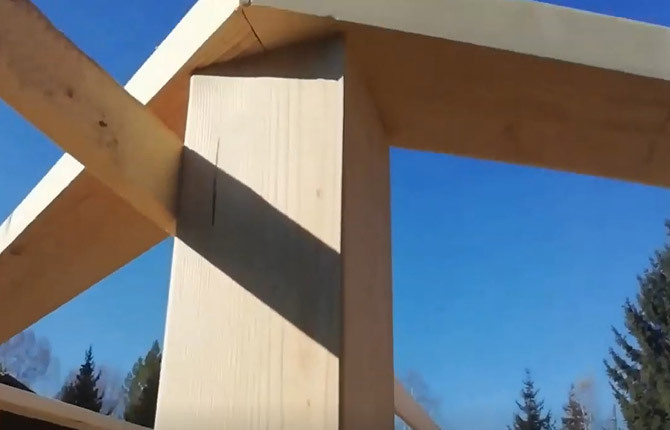
The blanks are laid out on the heads of the supports with an overlap. That is, on the pole, the edge of the workpiece should lie on top of the adjacent board. Next, the overlap is fixed and sawn with a hand saw along the midline. As a result, all boards are adjusted in size. It is only necessary to number them so as not to confuse them if the upper trim of the hexagonal housing has to be disassembled.
Important! All parts of the hexagonal gazebo are assembled with self-tapping screws using a screwdriver. Only the floor can be stuffed with nails on the logs.
After mounting the top trim, it will be necessary to sand the posts and boards of the top trim: remove burrs, possible chipping of the wood surface. There should not be any sharp edges.
Before making the hexagonal roof of the gazebo, it is necessary to install the railing of the future fence. They will not interfere with work, but at the same time they will seriously increase the rigidity or stability of the vertical supports.
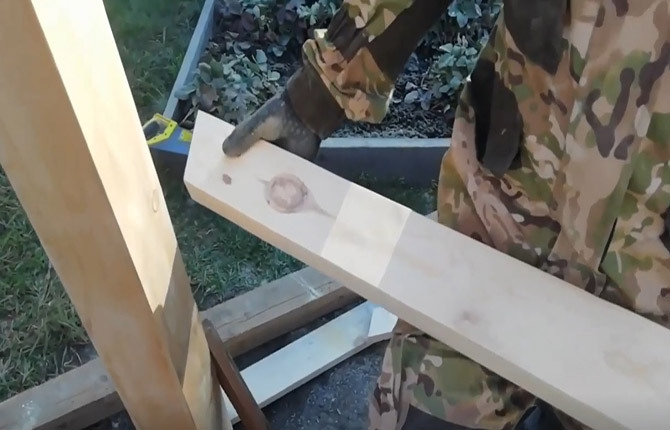
Each workpiece has to be cut individually to size, it is important to make the right angle washed down so that there is no gap between the support and the end of the workpiece. The fence of the gazebo is fixed with 70 mm self-tapping screws.
The fence itself is stuffed from a lining of 90 mm, part can be made of a crate from a 30x30 mm rail.
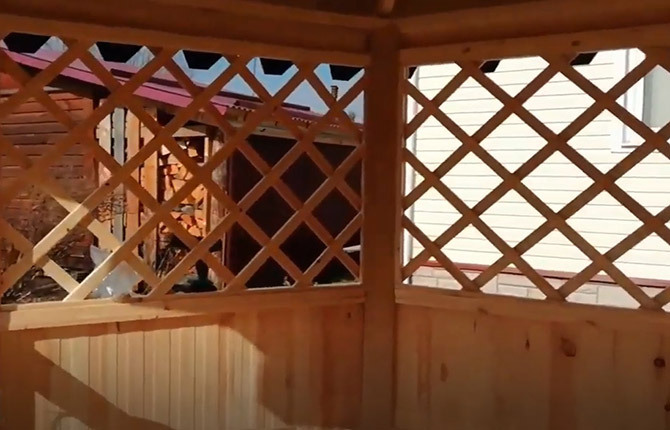
The windows of the hexagonal gazebo are completely clogged with a crate.
Roof erection
The next step is to assemble the truss frame. For this, a hex center will be used. Each rafter must be adjusted in length, and most importantly - in the angle of inclination.

Therefore, the hexagonal center is laid on the table, the edge of the rafter is applied to its edge, marked and cut at an angle. After that, the edge of the center and the rafter are numbered so as not to be confused. The hex center only looks perfectly even, in fact there are dimensional errors. Therefore, each rafter has to be individually adjusted in size.
The frame under the roof of the gazebo is assembled "on the ground". Since the roof is hexagonal, the rafters are attached to the center in pairs and at the same time the pair is reinforced with a spacer bar.
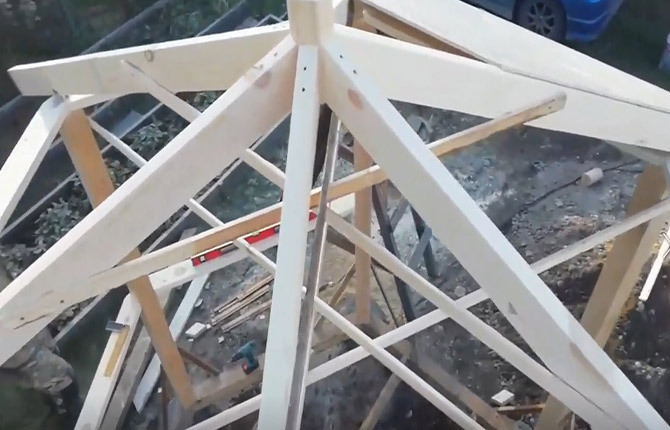
After mounting all the rafters, the frame is once again checked for symmetry and lifted onto the poles. The rafters are fixed to the heads with the help of steel corners and self-tapping screws.
The frame of the hexagonal gazebo is almost ready. It is only necessary to lay bituminous tiles.
For hexagonal arbors, in addition to soft roofing, they use corrugated board, metal tiles, slate, ondulin. But shingles for a hexagonal roof are best suited. It is easier to lay it on a slope, and if you do not make gross mistakes, then a tiled roof on a hexagonal gazebo will easily stand for 20-25 years.
The only drawback of tiles is that under it you need to make a continuous crate of waterproof plywood or OSB. Moreover, each sector of the roof has its own dimensions. Therefore, it is impossible to cut out one triangle from the OSB and follow it, as if according to a template, to make all the rest.
In each case, you have to lift a whole sheet of OSB onto the roof, try it on in place, mark it, and then cut out a blank for the roof on the table.
With correctly marked markings, the edges of the workpiece will rest on the rafter without going beyond the median line.
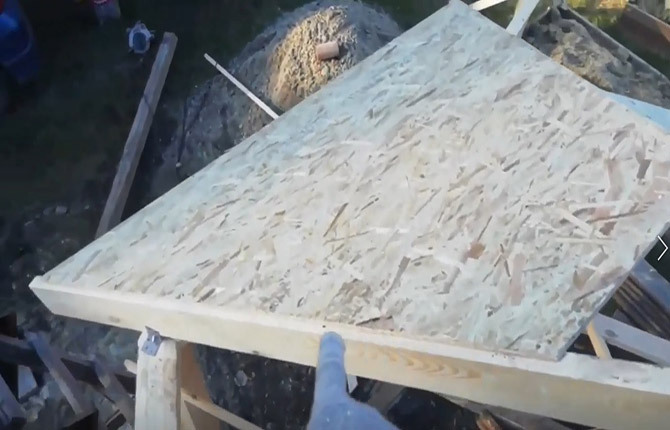
The second part of the sector is also cut out individually. It is smaller, so for the manufacture of the "tops" of the triangles, trimmings and waste from cutting the main sheets are used. OSB boards on the rafters of a hexagonal gazebo are fixed with carpentry screws.
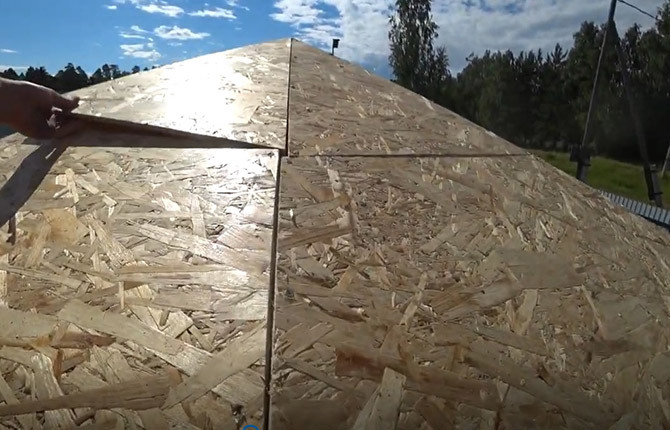
If the base under the shingles is laid correctly, then the joints will not be visible. But just in case, the joint can be puttied and rubbed with a grinder.
Roof selection and installation
Next, you need to lay the roofing on the roof. The first or starting row must be carefully aligned along the overhang line. At the same time, check with the location of the starting lanes in other sectors. If visually the tile is laid evenly, then it can be attached to the OSB base. For this, a conventional furniture stapler with a staple height of 10 mm is used. This is enough to fix the roofing of the gazebo without glue.
The roof of a hexagonal gazebo is considered the most complex part of the structure. Therefore, errors are often made in the marking of OSB pieces, cracks appear, there is a chance that water can flow under the shingles. Therefore, all flaws, cracks, inconsistencies are clogged with sealant.
After assembling the roof and laying the bituminous tiles, it will be necessary to install additional heels under the overhangs. They are installed on the strapping on the inside of the roof. You will need to cut out six "triangles" 150x100 mm, knock them under the slope, and then fix them with self-tapping screws.
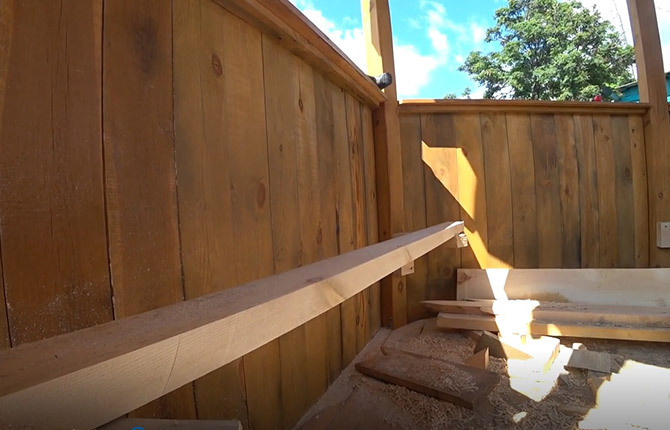
The final operation is the processing of all parts of the hexagonal gazebo with protective impregnation against bark beetles and fungus. Particular attention to the lower harness and floor. In these places, processing must be performed at least three times. After a day or two, the wooden building is varnished. You can use regular pentaphthalic or acrylic. For the floor - only polyurethane varnish.
Selection for you:
- Arbors with their own hands made of wood
- How to build a comfortable metal gazebo with your own hands
- We build a gazebo from polycarbonate with our own hands
- How to make a gazebo from a profile pipe with your own hands
- We make a gazebo from improvised materials with our own hands
- We build a modern gazebo with a barbecue for a summer residence with our own hands
- How to make a beautiful gazebo from pallets
- Do-it-yourself gazebo with a pitched roof
Results
Building a hexagonal gazebo is not as difficult as it might seem at first glance. The only difficulty is that most of the operations are the individual fitting of parts to size. It requires skills, patience, accuracy in work. All other operations are standard.
Tell us about your experience with building wooden arbors with a hexagonal roof. What do you think is the complexity of such buildings? Also save the article to bookmarks and share it on social networks.

